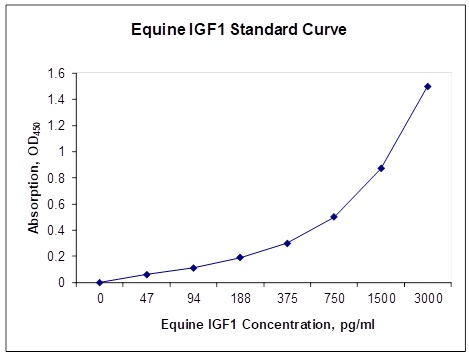Nori Equine IGF-1 ELISA Kit
$461.00 – $832.00
DataSheet CoA SDS
This ELISA kit is for quantification of IGF-1 in horse. This is a quick ELISA assay that reduces time to 50% compared to the conventional method, and the entire assay only takes 3 hours. This assay employs the quantitative sandwich enzyme immunoassay technique and uses biotin-streptavidin chemistry to improve the performance of the assays. An antibody specific for IGF-1 has been pre-coated onto a microplate. Standards and samples are pipetted into the wells and any IGF-1 present is bound by the immobilized antibody. After washing away any unbound substances, a detection antibody specific for IGF-1 is added to the wells. Following wash to remove any unbound antibody reagent, a detection reagent is added. After intensive wash a substrate solution is added to the wells and color develops in proportion to the amount of IGF-1 bound in the initial step. The color development is stopped, and the intensity of the color is measured.
Alternative names for IGF-1: Insulin-like growth factor 1, IGF1
This product is for laboratory research use only not for diagnostic and therapeutic purposes or any other purposes.
- Description
- How Elisa Works
- Product Citation
- Reviews (0)
Description
Nori Equine IGF-1 ELISA Kit Summary
Alternative names for IGF-1: Insulin-like growth factor 1, IGF1
Alternative names for equine: Horse
| Assay Type | Solid Phase Sandwich ELISA |
| Format | 96-well Microplate or 96-Well Strip Microplate |
| Method of Detection | Colorimetric |
| Number of Targets Detected | 1 |
| Target Antigen Accession Number |
P51458 |
| Assay Length | 3 hours |
| Quantitative/Semiquantitative | Quantitative |
| Sample Type | Plasma, Serum, Cell Culture, Urine, Cell/Tissue Lysates, Synovial Fluid, BAL, |
| Recommended Sample Dilution (Plasma/Serum) | No dilution for sample <ULOQ; sufficient dilution for samples >ULOQ |
| Sensitivity | 8 pg/mL |
| Detection Range | 47-3000 pg/mL |
| Specificity | Natural and recombinant horse IGF-1 |
| Cross-Reactivity | < 0.5% cross-reactivity observed with available related molecules, < 50% cross-species reactivity observed with species tested. |
| Interference | No significant interference observed with available related molecules |
| Storage/Stability | 4 ºC for up to 6 months |
| Usage | For Laboratory Research Use Only. Not for diagnostic or therapeutic use. |
| Additional Notes | The kit allows for use in multiple experiments. |
Standard Curve
Kit Components
1. Pre-coated 96-well Microplate
2. Biotinylated Detection Antibody
3. Streptavidin-HRP Conjugate
4. Lyophilized Standards
5. TMB One-Step Substrate
6. Stop Solution
7. 20 x PBS
8. Assay Buffer
Other Materials Required but not Provided:
1. Microplate Reader capable of measuring absorption at 450 nm
2. Log-log graph paper or computer and software for ELISA data analysis
3. Precision pipettes (1-1000 µl)
4. Multi-channel pipettes (300 µl)
5. Distilled or deionized water
Protocol Outline
1. Prepare all reagents, samples and standards as instructed in the datasheet.
2. Add 100 µl of Standard or samples to each well and incubate 1 h at RT.
3. Add 100 µl of Working Detection Antibody to each well and incubate 1 h at RT.
4. Add 100 µl of Working Streptavidin-HRP to each well and incubate 20 min at RT.
5. Add 100 µl of Substrate to each well and incubate 5-30 min at RT.
6. Add 50 µl of Stop Solution to each well and read at 450 nm immediately.
Background:
IGF-1 is a hormone similar in molecular structure to insulin.[1] It plays an important role in childhood growth and continues to have anabolic effects in adults. A synthetic analog of IGF-1, mecasermin, is used for the treatment of growth failure.[2] IGF-1 consists of 70 amino acids in a single chain with three intramolecular disulfide bridges. IGF-1 has a molecular weight of 7,649 daltons.[3] IGF-1 is produced throughout life primarily by the liver as an endocrine hormone as well as in target tissues in a paracrine/autocrine fashion. Production is stimulated by growth hormone (GH) and can be retarded by under-nutrition, growth hormone insensitivity, lack of growth hormone receptors, or failures of the downstream signaling pathway post GH receptor including SHP2 and STAT5B. Approximately 98% of IGF-1 is always bound to one of 6 binding proteins (IGF-BP). IGFBP-3, the most abundant protein, accounts for 80% of all IGF binding. IGF-1 binds to IGFBP-3 in a 1:1 molar ratio. IGFBP-1 is regulated by insulin. The highest rates of IGF-1 production occur during the pubertal growth spurt. The lowest levels occur in infancy and old age. Its primary action is mediated by binding to its specific receptor, the insulin-like growth factor 1 receptor (IGF1R), which is present on many cell types in many tissues. IGF-1 is a primary mediator of the effects of growth hormone (GH). Patients with severe primary insulin-like growth factor-1 deficiency (IGFD) may be treated with either IGF-1 alone or in combination with IGFBP-3.[4] Mecasermin (brand name Increlex) is a synthetic analog of IGF-1 which is approved for the treatment of growth failure.[4] IGF-1 has been manufactured recombinantly on a large scale using both yeast and E. coli.
References
- Jansen M, et al. (1983). Nature 306 (5943): 609–11.
- Keating G (2008). “Mecasermin”. BioDrugs 22 (3): 177–88.
- Rinderknecht E, Humbel R (1978). J Biol Chem 253 (8): 2769–2776.
- Rosenbloom A (2007). Opin. Pediatr. 19 (4): 458–64.
Product Citation
Be the first to review “Nori Equine IGF-1 ELISA Kit”
You must be logged in to post a review.





























Reviews
There are no reviews yet.